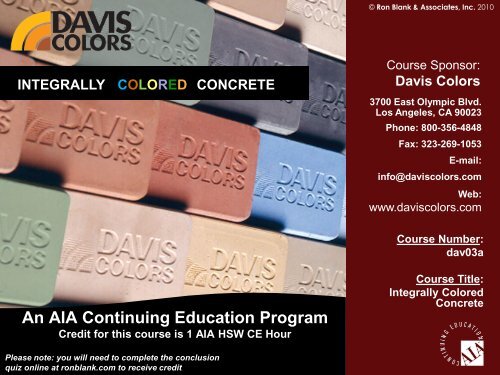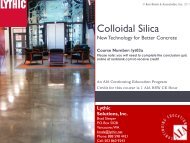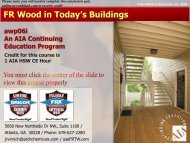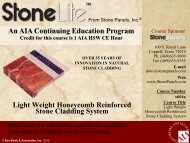Davis Colors COLORED CONCRETE - Ron Blank & Associates, Inc.
Davis Colors COLORED CONCRETE - Ron Blank & Associates, Inc.
Davis Colors COLORED CONCRETE - Ron Blank & Associates, Inc.
- No tags were found...
Create successful ePaper yourself
Turn your PDF publications into a flip-book with our unique Google optimized e-Paper software.
© <strong>Ron</strong> <strong>Blank</strong> & <strong>Associates</strong>, <strong>Inc</strong>. 2010Integrally Colored ConcreteINTEGRALLY<strong>COLORED</strong> <strong>CONCRETE</strong>Course Sponsor:<strong>Davis</strong> <strong>Colors</strong>3700 East Olympic Blvd.Los Angeles, CA 90023Phone: 800-356-4848Fax: 323-269-1053E-mail:info@daviscolors.comWeb:www.daviscolors.comCourse Number:dav03aAn AIA Continuing Education ProgramCredit for this course is 1 AIA HSW CE HourCourse Title:Integrally ColoredConcretePlease note: you will need to complete the conclusionquiz online at ronblank.com to receive credit
An American Institute of Architects (AIA)Continuing Education ProgramApproved Promotional Statement:<strong>Ron</strong> <strong>Blank</strong> & <strong>Associates</strong>, <strong>Inc</strong>. is a registered provider with The American Institute ofArchitects Continuing Education System. Credit earned upon completion of thisprogram will be reported to CES Records for AIA members. Certificates ofCompletion are available for all course participants upon completion of the courseconclusion quiz with +80%.Please view the following slide for more information on Certificates of Completion through RBAThis program is registered with the AIA/CES for continuingprofessional education. As such, it does not include content that maybe deemed or construed to be an approval or endorsement by the AIAor <strong>Ron</strong> <strong>Blank</strong> & <strong>Associates</strong>, <strong>Inc</strong>. of any material of construction or anymethod or manner of handling, using, distributing, or dealing in anymaterial or product.
An American Institute of Architects (AIA)Continuing Education ProgramCourse Format: This is a structured, web-based, self study course with a final exam.Course Credit: 1 AIA Health Safety & Welfare (HSW) CE HourCompletion Certificate: A confirmation is sent to you by email and you can print one uponsuccessful completion of a course or from your <strong>Ron</strong><strong>Blank</strong>.com transcript. If you have anydifficulties printing or receiving your Certificate please send requests tocertificate@ronblank.comDesign professionals, please remember to print your certificate ofcompletion after successfully completing a course conclusion quiz.All AIA and non-AIA members will be sent a copy of their certificateto the email address they have provided in their <strong>Ron</strong><strong>Blank</strong>.comaccount.Please note: you will need to complete the conclusion quizonline at ronblank.com to receive credit
Course DescriptionFind everything you need to know aboutcoloring concrete with integral (mixed in) colors.Review the wide spectrum of colors that areused, the application process, and the benefitsof integral color concrete that give it a longlastingappeal.
Course ObjectivesUpon completion of this course the designer will beable to: Describe the application of integrally coloredconcrete Explain how color affects concrete properties Describe how concrete is integrally colored List the finishing techniques used
Pre-TestLet’s find out what you know about integrally colored concreteWhat is the typical color dosage (%)?a) 5% of concrete volumeb) 7% of cement volumec) 10% of concrete volumed) 10% of cement volume
Pre-TestLet’s find out what you know about integrally colored concreteFor integral color, when is color added?a) After concrete curesb) During concrete finishingc) Mixed before pourd) Sprinkled or dusted after finishing
Pre-TestLet’s find out what you know about integrally colored concreteWhat, besides pigment, affects concretecolor most?a) Aggregateb) Cement-water ratioc) Sand plus aggregated) Cement
Pre-TestLet’s find out what you know about integrally colored concreteWhere can colored concrete be used?a) Concrete drives /walksb) Anything made with concretec) Pavers/blocksd) Tilt-up
Concrete Can Be Beautiful• Gray concrete is so common thatfew people realize concrete can becolored.• Color adds to the aesthetic potentialof concrete, transforming it from anordinary building material into amedium for creative design.• Integral color is mixed right intoconcrete.• A vast color palette plus custommatches are available.
Colored Concrete is Practical• <strong>Colors</strong> are easily mixed into anytype of concrete and installation isthe same as with high-qualityuncolored concrete.• Integrally colored concrete isdurable and has a long service life.The color is permanent and will lastfor as long as the concrete surfaceitself.• <strong>Colors</strong> do not fade but the color willwear as concrete wears.
Colored Concreteis Affordable• Colored concrete is installedand finished the same asconventional concrete.• No separate finish or stainingis required; reducing costs.• Excellent alternative to moreexpensive materials such asnatural stone or quarry tile.
Use <strong>Colors</strong> in Buildings• Integral colored CMU • Concrete walks
Use <strong>Colors</strong> in Paving• Integral colored concrete walks
Use <strong>Colors</strong> in Structures• Custom colored cast-in-place concrete structures
Anywhere your imagination takes you• Stamped concrete paving • Pre-cast sculptures
The Color of ConcreteMasonry Units• Concrete Masonry Units (CMU) -They aren’t your grandfather’s cinderblock anymore. <strong>Colors</strong>, combinedwith finishes such as split-face, slumpblock, or sandblasted or other stylesof CMU, make it attractive to use inarchitectural projects.• With integral colors, you don’t have topaint for good looks. Integral colorsare as durable as the concrete, soyou save on maintenance throughouta building’s life.
The <strong>Colors</strong> in Concrete Pavers• Renowned for durability aswell as beauty, interlockingconcrete pavers come in awide range of shades,blends, and patterns toenhance the appeal of drives,walks, plazas and otherhardscapes.• <strong>Colors</strong> withstand deicingsalts, fuel spills, andexposure to the elements.
The Color ofSegmental Retaining Wall (SRW) Units• SRW’s are gaining popularity as aneconomical and practical way to buildretaining walls. They can be tintedwith colors to complement or blendwith the earth tone hues.
The Color of Precast Concrete• According to the Precast/PrestressedConcrete Institute, “The properelection of color, form, and texture iscritical to the aesthetic appearance ofarchitectural precast concrete.”• Exposed aggregate finishes are oftenused in precast work. Integrallycolored concrete provides abackground matrix that accentuatesthe color of the aggregates.
Color of Tilt-Up Concrete• No longer limited to use inwarehouses and factories,tilt-up offers more designflexibility than once thoughtpossible.• Integrally colored tilt-uppanels take advantage of thenatural appearance ofexposed concrete andprovide an attractivealternative to painting.
Tilt-Up Coloring Techniques• To reduce the amount of color required, tilt-up panels canoften be poured with a thin colored face veneer anduncolored concrete used for the balance of the panelthickness.
How is Color Added?• One method is to toss disintegratingbags (bag & all) directly into aconcrete mixer. Color additives arereleased deep inside the mixer sopigments disperse uniformly.Disintegrating bags make it easy forContractors and Producers to colorconcrete and keep trash out of theenvironment.• Another method is a sophisticatedcomputerized liquid color systemthat mixes the color & injects thecolor directly into the mixer.
What Determines theColor of Concrete?• Low dosages createsubtle hues.• Higher dosages createdeeper or more intenseconcrete colors.• If dosages exceed 6% ofthe cement content, colorsaturation occurs andadding additional coloradditives will not enhancethe concrete color.
What Determines theColor of Concrete?• <strong>Colors</strong> are made from metal or mineral oxides eitherrecycled from iron or refined from the earth. They complywith ASTM C979 - Pigments for Integrally ColoredConcrete are specially processed for mixing in concreteand uniform tinting strength.• Specially processed carbon black color additives can alsobe used in concrete which is not air-entrained and issealed against water penetration.
What Determines the Color of Concrete?• The shade of Portland cement also affects the color of theconcrete. Portland cement varies from white to gray or buffin color. White Portland cement can be used to producepastel shades of concrete.• These concrete tiles show the effect that base cementcolor has on both colored and uncolored samples.(Top row colored, middle uncolored and bottom is the cement used)
What Determines theColor of Concrete?• To a lesser extent, the sand andaggregate color will have anaffect on concrete color.• Over time, heavy traffic &erosion can wear off the coloredcement paste at the surface ofthe concrete exposing theaggregate.• Exposed aggregate can affectsurface color.• Coordinate the type and color ofaggregates to be used when anexposed finish is scheduled.
A Word About ColorUniformity• Some customersunrealistically expect coloredconcrete to be uniform inappearance like a paintedsurface.• It is more realistic tocompare colored concretewith handcrafted and naturalbuilding materials.• As with stone and wood,minor variations inappearance contribute to thematerial’s aesthetic appeal.
Mix Design• Colored concrete is available readymixedfrom most concrete producersand contractors. Your concreteproducer can help you determine thepigments and dosage rates requiredto achieve the desired shade.• Maximum dosage rate of color shouldnot exceed 10% of weight of cementcontent. Typical rates are 1% to 5%.• Each component of the concreteshould be from a single source,uniform in color, and consistentlyproportioned.
Mix Design• Specify a maximum 5”(12.5 cm) slump for allintegrally colored concretework. If greater slump orworkability is required,specify the addition ofwater-reducing orplasticizing admixturesinstead of added water.• In locations subject to freeze-thaw conditions, specify aircontent range of 5% to 7% for improved workability anddurability.
Mock-Up• Use a mock-up on large orcomplex projects. This willmake sure that thetechniques and materialsused by the contractor willproduce the desiredappearance.• Mock-ups should beconstructed a month beforestart of concrete work toallow concrete to fully curebefore final inspection.
Concrete Finishes• A wide variety of attractivefinishes are possible withcolored concrete. A few of themore popular finishes areshown on the following slides.• Textured surfaces producemore uniform looking concretethan smooth troweled orformed surface because theroughness of the surfacescatters light reflecting off theconcrete.
Broomed Finish• Made by pulling special broomsacross stiff, freshly floated ortroweled surface.• For variety, broom texture can beheavy or light, or in straight or wavylines or swirls.• Textured surfaces are more slipresistantwhen wet than smoothtroweled floors and paving.
Exposed Aggregate Finish• Aggregate is exposed by “seeding”fresh concrete with aggregate, orby spraying a set-retardingcompound on fresh concrete andscrubbing the cement paste fromthe surface.• Aggregate can also be exposed byremoving the surface cementpaste with a high-pressure waterwash, sand blasting, grinding, orbush hammering. Aggregates canbe colored or sparkling, fracturedor smooth.
Salt Finish• Rock salt is pressed into thesurface after finishing. After24 hours, the salt is washedaway with water and a brush.• This finish is notrecommended in cold areaswhere water could collectand freeze in pockets.
Pattern Stamped Finish• Special stamping tools are pressedinto the concrete to create a patternor texture. There are now craftsmenin all parts of the country who areskilled in the techniques of patternstamping.
Form Liner Finish• Form liners allow endlessdesign possibilities fortexture, pattern, and relief.• They are available in a widerange of standard patternsas well as custom designs.
Curing Colored Concrete• Uneven Curing = UnevenDrying = Uneven Color.• Colored concrete should becured with curing compoundsspecifically recommended forcolored concrete. Curing withwater, membrane sheets, ornon-approved compounds candiscolor concrete.
Locating a QualifiedContractor• Ask your local Ready-Mixproducer for names ofreputable concrete contractors.• Visit http://www.concretepalette.comfor a free nationwide listing ofconcrete contractors.
Course SummaryUpon completion of this course the designer will beable to: Describe the application of integrally coloredconcrete Explain how color affects concrete properties Describe how concrete is integrally colored List the finishing techniques used
© <strong>Ron</strong> <strong>Blank</strong> & <strong>Associates</strong>, <strong>Inc</strong>. 2010Integrally Colored ConcreteINTEGRALLY<strong>COLORED</strong> <strong>CONCRETE</strong>Course Sponsor:<strong>Davis</strong> <strong>Colors</strong>3700 East Olympic Blvd.Los Angeles, CA 90023Phone: 800-356-4848Fax: 323-269-1053E-mail:info@daviscolors.comWeb:www.daviscolors.comCourse Number:dav03aAn AIA Continuing Education ProgramCredit for this course is 1 AIA HSW CE HourCourse Title:Integrally ColoredConcretePlease note: you will need to complete the conclusionquiz online at ronblank.com to receive credit
















